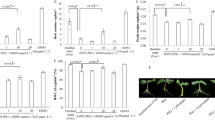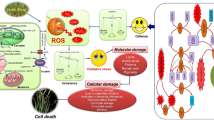Abstract
Physiological effects of lanthanum ions on the activities of the enzymes in the reactive oxygen species (ROS) scavenging system in leaves of wheat (Triticum aestivum L.) seedlings were studied. Wheat leaves treated in Hogland solution with 0.1 mM LaCl3 for 48 h showed increased levels of superoxide dismutase (SOD), catalase (CAT), ascorbate-specific peroxidase (AsA-POD), and dehydroascorbate reductase (DHAR). However, a minor effect was observed on the levels of monodehydroascorbate reductase (MDAR) and glutathione reductase (GR), which regulate the release of energy required by the ROS scavenging system. The whole system was linked up by H+ transmission. Our results indicated that the activities of the enzymes that function directly to remove ROS were elevated by La3+ treatment, which is consistent with the observations that La3+-treated plants had increased tolerance to environmental stresses. The remaining levels of MDAR and GR suggested that these two enzymes might be regulated differently from that of the other four enzymes studied.
Similar content being viewed by others
References
A. H. Price and G.A.F. Hendry, Plant under drought-stress generate activated oxygen, Free Radical Res. Commun. 8, 1–66 (1989).
M. Y. Jiang and Sh. Ch. Guo, The osmotic stress induced by water deficiency and the anioxidant action in plant, Plant Physiol. Commun. 32(2), 144–150 (1996) (in Chinese).
E. J. Kendall and B. D. Mckersie, Free radical and freezing injury to cell membrane of winter wheat, Plant Physiol. 78(1), 86–94 (1989).
C. Mehdy, Active oxygen species in plan defence against pathogens, Plant Physiol. 105, 467–472 (1994).
B. Halliwell and J.M.C. Cutteridge, Free Radicals in Biology and Medicine, B. Halliwell and J.M.C. Cutteridge, eds., Clarendon, Oxford (1989).
P. I. Popham and A. Novacky, Use of dimethyl sulfoxide to detect hydrogen radical during bacteria-induced hypersensitive reaction, Plant Physiol. 96, 1157–1160 (1991).
Q. Lu and R. L. Zheng, Water stress and active oxygen set off wheat membrane lipid peroxidation and deesterification, Sci. China (Ser. c), 26(1), 26–30 (1996) (in Chinese).
M. A. Hossain and K. Asada, Purification of dehydroascorbate reductase from spinach and its characterization as thiol enzyme, Plant Cell Physiol. 25(1), 85–92 (1984).
Y. W. He and C. S. Loh, Cerium and lanthanum promote floral initiation and reproductive growth of Arabidopsis thaliana, Plant Sci. 159(1), 117–124 (2000).
J. Y. Wu, C. G. Wang, and X. G. Mei, Stimulation of taxol production and excretion in Taxus spp cell cultures by rare earth chemical lanthanum, J. Biotechnol. 85(1), 67–73 (2001).
E. Diatloff, F. W. Smith, and C. J. Asher, Rare-earth elements and plant-growth. 2. Responses of corn and mungbean to low concentrations of lanthanum in dilute, continuously flowing nutrient solutions, J. Plant Nutr. 18(10), 1977–1989 (1995).
H. L. Zheng, Z. Q. Zhao, C. G. Zhang, J. Z. Feng, Z. L. Ke, and M. J. Su, Changes in lipid peroxidation, the redox system and ATPase activities in plasma membranes of rice seedling roots caused by lanthanum chloride, Biometals 13(2), 157–163 (2000).
W. P. Chen and P. H. Li, Chilling-induced Ca2+ overload enhances production of active oxygen species in maize (Zea mays L.) cultured cells: the effect of abscisic acid treatment, Plant Cell Environ. 24(8), 791–800 (2001).
F. L. Zeng, Y. An, H. T. Zhang, and M. F. Zhang, The effects of La (III) on the peroxidation of membrane lipids in wheat seedling leaves under osmotic stress, Biol. Trace Element Res. 69(2), 141–150 (1999).
O. Myhre and F. Fonnum, The effect of aliphatic, naphthenic, and aromatic hydrocarbons on production of reactive oxygen species and reactive nitrogen species in rat brain synaptosome fraction: the involvement of calcium, nitric oxide synthase, mitochondria, and phospholipase A, Biochem. Pharmacol. 62(1), 119–128 (2001).
A. H. Price, A. Taylor, S. J. Ripley, A. Griffiths, A. J. Trewavas, and M. R. Knight, Oxidative signals in tobacco increase cytosolic calcium, Plant Cell 6(9), 1301–1310 (1994).
C. N. Cianopolitis and S. K. Ries, Superoxide dismutase I. Occurrence in higher plants, Plant Physiol, 59, 309–314 (1997).
C. O. Beauchamp and I. Fridovich, Superoxide dismutase: improved assays and an assay applicable to acrylamide gels, Anal. Biochem. 44, 276–287 (1971).
R. F. Beers and I. W. Sizer, A spectrophotometric method for measuring the breakdown of hydrogen peroxide by catalase, J. Biol Chem. 195, 133 (1952).
Y. Nakano and K. Asada, Hydrogen peroxide is scavenged by ascorbate-specific peroxidase in spinach chloroplast, Plant Cell Physiol. 22(5), 867–880 (1981).
M. A. Hossain and K. Asada, Purification of dehydroascorbate reductase from spinach and its characterization as thiol enzyme, Plant Cell Physiol. 25(1), 85–92 (1984).
M. A. Hossain, Y. Nskano, and K. Asada, Monodehydroascorbate reductase in spinach chloroplasts and its participation in regeneration of ascorbate for scavenging hydrogen peroxide, Plant Cell Physiol. 2S(3), 85–395 (1984).
M. Schaedle and J. A. Bassham, Chloroplast glutatione reductase, Plant Physiol. 59, 1011–1012 (1977).
M. M. Braford, A rapid sensitive method for the quantitation of microgram quantities of protein utilizing the principle of protein-dye binding, Anal. Biochem. 72, 248–254 (1976).
Y. Y. Hou, L. H. Jing, and F. L. Zeng, The research on the effect of La3+ in the damage of wheat seedling leaves under drought stress, Acta Bot. Boreal-Occthent. Sci. 21(6), 1134–1141 (2001).
B. L. Shen and X. B. Dai, The effect of rare earth elements on wheat chloroplast photoreaction, Chin. Rare Earths 15(2), 71–72 (1994) (in Chinese).
T. W. Miller and J. M. Tormey, Calcium displacement by lanhanum in subcellular compamments of rat ventricular myocytes: characterisation by electron-probe microanalysis, Cardiovasc. Res. 27, 2106–2112 (1993).
W. J. Chen, Y. H. Gu, S. B. Wang, and G. W. Zhao, Effect of lamhanum on RuBPCase activity of tobacco seedlings, J. Rare Earths 19(2), 129–133 (2001).
A. Deisseroth and A. L. Dounce, Catalase: physical and chemical properties, mechanism of catalysis and physiological role, Physiol. Rev. 50, 319–375 (1970).
F. L. Zeng, P. Shi, M. F. Zhang, and R. W. Deng, Effect of lanthanum on ion absorption cucumber seedling leave, Biol. Trace Element Res. 78(1–3), 265–270 (2000).
Author information
Authors and Affiliations
Rights and permissions
About this article
Cite this article
Zhang, L., Zeng, F. & Xiao, R. Effect of lanthanum ions (La3+) on the reactive oxygen species scavenging enzymes in wheat leaves. Biol Trace Elem Res 91, 243–252 (2003). https://doi.org/10.1385/BTER:91:3:243
Received:
Revised:
Accepted:
Issue Date:
DOI: https://doi.org/10.1385/BTER:91:3:243




